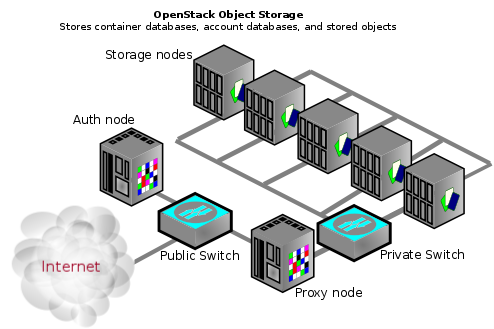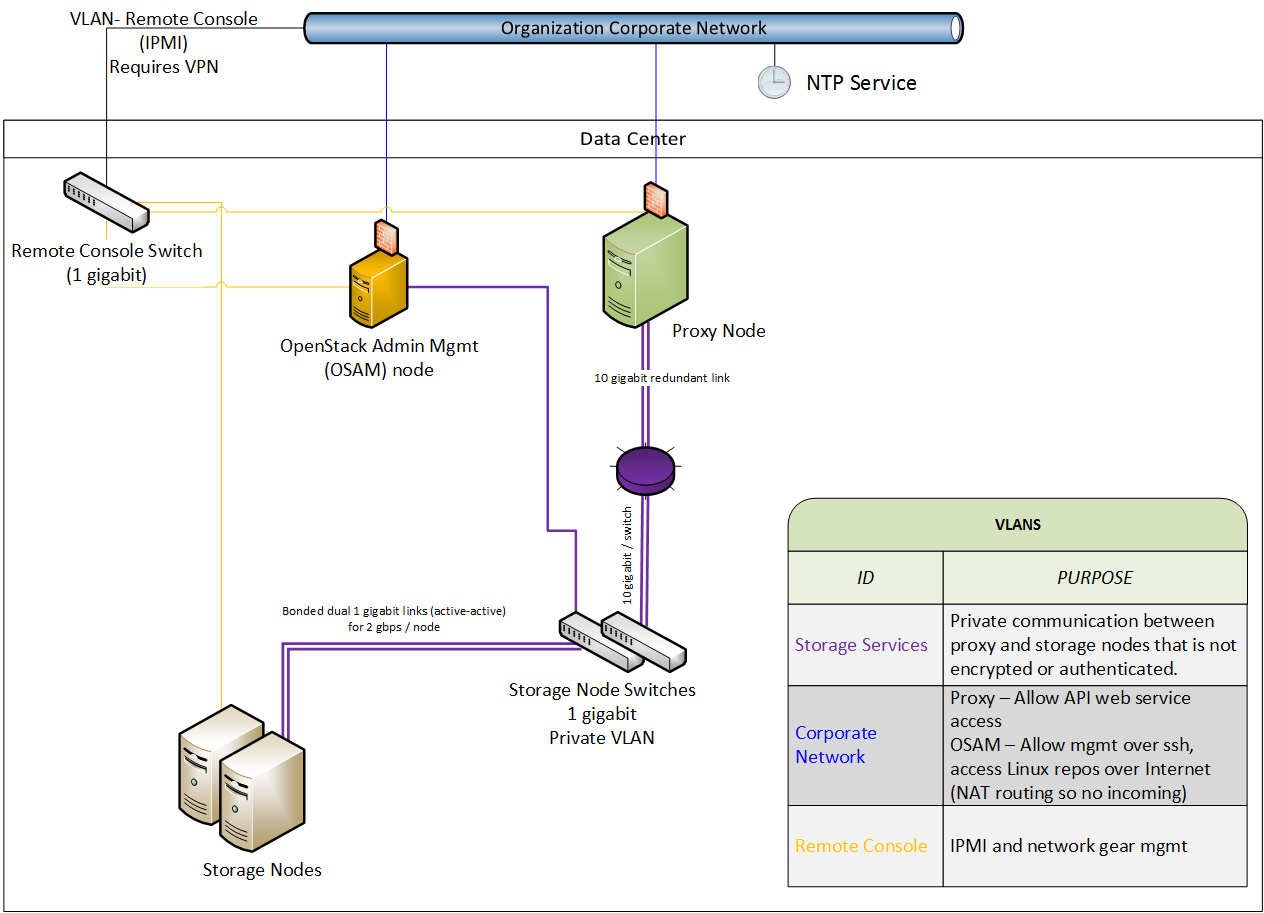Chapter 8. Object Storage
The Object Storage (swift) service stores and retrieves data over HTTP. Objects (blobs of data) are stored in an organizational hierarchy that can be configured to offer anonymous read-only access, ACL defined access, or even temporary access. Swift supports multiple token-based authentication mechanisms implemented through middleware.
Applications store and retrieve data in Object Storage using an industry-standard HTTP RESTful API. The back end swift components follow the same RESTful model, although some APIs (such as those managing durability) are kept private to the cluster.
The components of swift fall into the following primary groups:
- Proxy services
- Auth services
Storage services
- Account service
- Container service
- Object service

An Object Storage installation does not have to be internet-facing and could also be a private cloud with the public switch a part of the organization’s internal network infrastructure.
8.1. Network security
Security hardening for swift begins with securing the networking component. See the networking chapter for more information.
For high availability, the rsync protocol is used to replicate data between storage service nodes. In addition, the proxy service communicates with the storage service when relaying data between the client end-point and the cloud environment.
Swift does not use encryption or authentication with inter-node communications. This is because swift uses the native rsync protocol for performance reasons, and does not use SSH for rsync communications.This is why you see a private switch or private network ([V]LAN) in the architecture diagrams. This data zone should be separate from other OpenStack data networks as well.
Use a private (V)LAN network segment for your storage nodes in the data zone.
This requires that the proxy nodes have dual interfaces (physical or virtual):
- One interface as a public interface for consumers to reach.
- Another interface as a private interface with access to the storage nodes.
The following figure demonstrates one possible network architecture, using the Object Storage network architecture with a management node (OSAM):

8.2. General service security
8.2.1. Run services as non-root user
It is recommend that you configure swift to run under a non-root (UID 0) service account. One recommendation is the username swift with the primary group swift, as deployed by director. Object Storage services include, for example, proxy-server, container-server, account-server.
8.2.2. File permissions
The /var/lib/config-data/puppet-generated/swift/etc/swift/ directory contains information about the ring topology and environment configuration. The following permissions are recommended:
chown -R root:swift /var/lib/config-data/puppet-generated/swift/etc/swift/*
find /var/lib/config-data/puppet-generated/swift/etc/swift/ -type f -exec chmod 640 {} \;
find /var/lib/config-data/puppet-generated/swift/etc/swift/ -type d -exec chmod 750 {} \;
This restriction only allows root to modify configuration files, while still allowing the services to read them, due to their membership in the swift group.
8.3. Securing storage services
The following are the default listening ports for the various storage services:
-
Account service -
TCP/6002 -
Container service -
TCP/6001 -
Object Service -
TCP/6000 -
Rsync -
TCP/873
If ssync is used instead of rsync, the object service port is used for maintaining durability.
Authentication does not occur at the storage nodes. If you are able to connect to a storage node on one of these ports, you can access or modify data without authentication. To help mitigate this issue, you should follow the recommendations given previously about using a private storage network.
8.3.1. Object Storage account terminology
A swift account is not a user account or credential. The following distinctions exist:
- Swift account - A collection of containers (not user accounts or authentication). The authentication system you use will determine which users are associated with the account and how they might access it.
- Swift containers - A collection of objects. Metadata on the container is available for ACLs. The usage of ACLs is dependent on the authentication system used.
- Swift objects - The actual data objects. ACLs at the object level are also available with metadata, and are dependent on the authentication system used.
At each level, you have ACLs that control user access; ACLs are interpreted based on the authentication system in use. The most common type of authentication provider is the Identity Service (keystone); custom authentication providers are also available.
8.4. Securing proxy services
A proxy node should have at least two interfaces (physical or virtual): one public and one private. You can use firewalls or service binding to help protect the public interface. The public-facing service is an HTTP web server that processes end-point client requests, authenticates them, and performs the appropriate action. The private interface does not require any listening services, but is instead used to establish outgoing connections to storage nodes on the private storage network.
8.4.1. HTTP listening port
Director configures the web services to run under a non-root (no UID 0) user. Using port numbers higher than 1024 help avoid running any part of the web container as root. Normally, clients that use the HTTP REST API (and perform automatic authentication) will retrieve the full REST API URL they require from the authentication response. The OpenStack REST API allows a client to authenticate to one URL and then be redirected to use a completely different URL for the actual service. For example, a client can authenticate to https://identity.cloud.example.org:55443/v1/auth and get a response with their authentication key and storage URL (the URL of the proxy nodes or load balancer) of https://swift.cloud.example.org:44443/v1/AUTH_8980.
8.4.2. Load balancer
If the option of using Apache is not feasible, or for performance you wish to offload your TLS work, you might employ a dedicated network device load balancer. This is a common way to provide redundancy and load balancing when using multiple proxy nodes.
If you choose to offload your TLS, ensure that the network link between the load balancer and your proxy nodes are on a private (V)LAN segment such that other nodes on the network (possibly compromised) cannot wiretap (sniff) the unencrypted traffic. If such a breach was to occur, the attacker could gain access to endpoint client or cloud administrator credentials and access the cloud data.
The authentication service you use will determine how you configure a different URL in the responses to endpoint clients, allowing them to use your load balancer instead of an individual proxy node.
8.5. Object Storage authentication
Object Storage (swift) uses a WSGI model to provide for a middleware capability that not only provides general extensibility, but is also used for authentication of endpoint clients. The authentication provider defines what roles and user types exist. Some use traditional username and password credentials, while others might leverage API key tokens or even client-side x.509 certificates. Custom providers can be integrated using custom middleware.
Object Storage comes with two authentication middleware modules by default, either of which can be used as sample code for developing a custom authentication middleware.
8.5.1. Keystone
Keystone is the commonly used Identity provider in OpenStack. It may also be used for authentication in Object Storage.
8.6. Encrypt at-rest swift objects
Swift can integrate with Barbican to transparently encrypt and decrypt your stored (at-rest) objects. At-rest encryption is distinct from in-transit encryption, and refers to the objects being encrypted while being stored on disk.
Swift performs these encryption tasks transparently, with the objects being automatically encrypted when uploaded to swift, then automatically decrypted when served to a user. This encryption and decryption is done using the same (symmetric) key, which is stored in Barbican.
For more information, see the Barbican integration guide: https://access.redhat.com/documentation/en-us/red_hat_openstack_platform/15/html-single/manage_secrets_with_openstack_key_manager/
8.7. Additional items
In /var/lib/config-data/puppet-generated/swift/etc/swift/swift.conf on every node, there is a swift_hash_path_prefix setting and a swift_hash_path_suffix setting. These are provided to reduce the chance of hash collisions for objects being stored and avert one user overwriting the data of another user.
This value should be initially set with a cryptographically secure random number generator and consistent across all nodes. Ensure that it is protected with proper ACLs and that you have a backup copy to avoid data loss.

